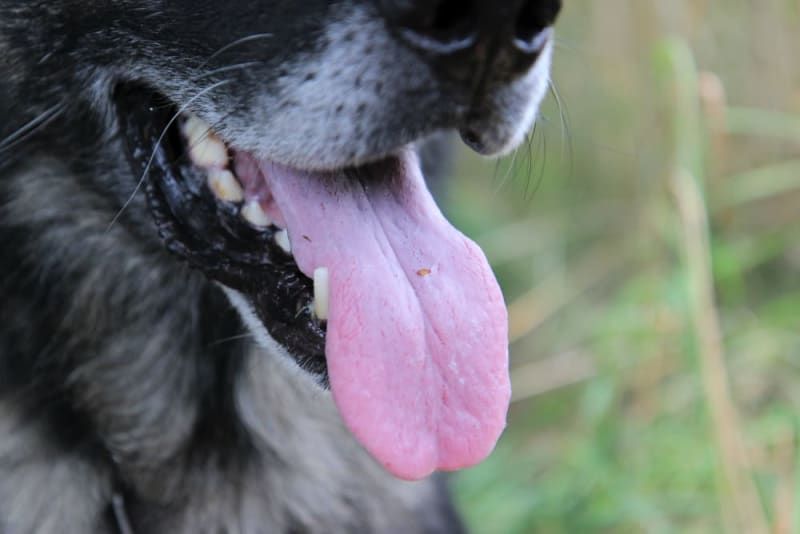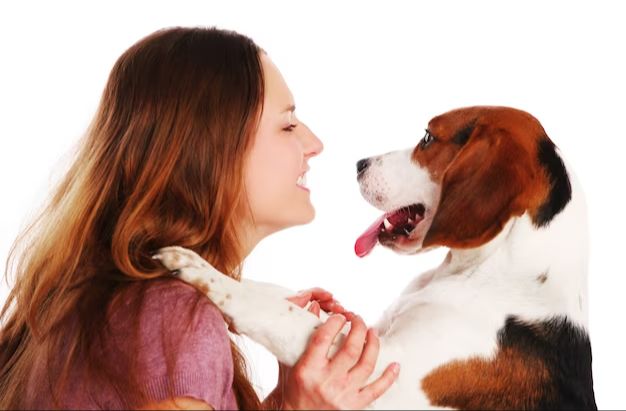Introduction
Tongue kissing your dog is an affectionate behavior that many dog owners engage in. However, this act often generates controversy and raises questions of health risks and appropriateness. At the core of the issue is whether or not it is okay to tongue kiss your dog.
The potential health implications of tongue kissing dogs has been debated, with some experts warning of transmission of bacteria and parasites while others argue the risks are overstated. Beyond medical considerations, there are cultural taboos against interspecies kissing as well as discussions around consent and the humanization of dogs.
This article will explore the debate around tongue kissing dogs by looking at the potential health risks, the human-dog bond, cultural views, training considerations, expert opinions, bonding alternatives, and summarizing the key takeaways on this controversial topic.
Potential Health Risks
There are some potential health risks to consider when tongue kissing your dog.
Bacterial Infections
Dogs’ mouths contain many more bacteria than human mouths. When a dog licks a person’s mouth, bacteria can be transferred. This exposes you to bacteria that can cause infections, including Pasteurella, Capnocytophaga, and Leptospirosis. Some of these bacteria could lead to pneumonia, flu symptoms, abscesses, blood poisoning, and bone infection if not treated promptly.

Parasites
Intestinal parasites like roundworms, hookworms, tapeworms and giardia can be passed from dogs to humans through licking. These parasites live in a dog’s intestines and shed eggs in their feces. The eggs can stick to a dog’s tongue when it cleans itself. When the dog then licks your mouth, the eggs can be transferred to you and make you sick if ingested.
Rabies
Though rare, rabies can be transmitted through a dog’s saliva. Rabies is a fatal viral infection that attacks the central nervous system. If you get infected but don’t receive treatment promptly, rabies can cause neurological symptoms and result in death. So kissing a dog on the mouth could potentially expose you to rabies, although the chances are very low if your dog is vaccinated.
Dog’s Oral Health
Dogs can suffer from dental problems just like humans. Plaque and tartar buildup can lead to gum disease, tooth decay and tooth loss if not properly treated. Some dogs are more prone to these oral health issues based on their breed, genetics, and overall health.
Allowing your dog to lick the inside of your mouth and tongue kissing them can transfer bacteria into their mouths. This bacteria can interact with existing plaque and tartar, potentially making oral health problems worse.
In addition, dogs naturally have more bacteria in their mouths than humans. Letting them lick your mouth introduces higher levels of bacteria, which can cause bad breath in both you and your dog.
Regular tooth brushing, dental chews, and professional cleanings from your vet can help minimize your dog’s plaque and tartar buildup. Avoiding open mouth kissing can also reduce the bacteria transfer that contributes to bad breath.
Human-Dog Bonding

Dogs release oxytocin, also known as the “love hormone” or “cuddle chemical”, in response to contact and interaction with humans. Oxytocin plays an important role in social bonding, promoting feelings of affection, attachment, calm, and well-being. When a dog owner interacts with their pet through activities like petting, playing, exercising, or grooming, oxytocin is released in both the human’s and dog’s brains.
This shared oxytocin release helps strengthen the emotional bond between people and their canine companions. Many dog owners report that their pets provide them with unconditional love, happiness, stress relief, comfort, and companionship. Physical contact like holding hands, hugging, snuggling and yes, even kissing a dog, can elevate mood, ease anxiety, and promote a sense of trust and intimacy between owners and their pets.
Dog kisses and close facial contact allow owners to gaze into their pet’s eyes, further facilitating the release of oxytocin. This helps explain why many dog parents enjoy smooching their pooches and receiving dog kisses, viewing this contact as a sign of affection. However, some boundaries and precautions need to be considered.
Cultural Views
Kissing dogs on the mouth, sometimes referred to as “wet kisses”, evokes strong reactions across cultures. While the practice has gained popularity in some areas, it remains taboo in others.
In Western cultures, mouth-kissing dogs is relatively common but not universally accepted. Many owners view it as an expression of affection. However, some consider it unhygienic or inappropriate. The taboo may be stronger in certain conservative or germophobic communities.
Acceptance varies across non-Western cultures as well. For example, mouth-kissing dogs is extremely rare in parts of the Middle East, where dogs are considered unsanitary. Yet in certain Aboriginal communities in Australia, kissing dogs is a tradition tied to bonding and protection.
Overall, cultural acceptance depends on attitudes around cleanliness, intimacy with pets, and the significance placed on the human-canine relationship. While mouth-kissing dogs has devotees, it remains controversial enough to be banned in many households and societies.
Training Considerations
Tongue kissing your dog can reinforce unwanted behavior and make setting boundaries more difficult. When a dog is rewarded with affection and attention for jumping up and licking a person’s mouth, it can reinforce this as an acceptable way for the dog to interact.
Instead, pet owners should aim to direct their dog’s energy into more constructive activities through training. This allows the owner to set clear boundaries for the dog’s behavior. Training a dog to sit and wait for permission before approaching and licking a person’s face is one way to discourage mouth-to-mouth contact while still encouraging affection.

Additionally, providing an alternative behavior for the dog to receive rewards and attention, such as obedience work or fetch, can fulfill the dog’s needs without reinforcing unwanted licking. With proper training and boundaries, affection can be shared in safer ways that are more appropriate for both pet and owner.
Risk Mitigation
While tongue kissing dogs is generally not recommended, there are some steps that can be taken to reduce the risks if you choose to allow this behavior:
Brush your dog’s teeth regularly – By brushing your dog’s teeth often, you can reduce the amount of bacteria and plaque in their mouth. Use a specially formulated dog toothpaste and toothbrush to gently clean their teeth and gums.
Wash your face after – Be sure to wash your face and mouth thoroughly with soap and water after engaging in any licking behavior with your dog. This will remove some of the bacteria that may have been transmitted.
However, the only way to completely avoid the risks is to refrain from tongue kissing. There are many other great ways to bond with your dog such as petting, playing, exercising together and positive reinforcement training.
Expert Opinions
Most veterinarians and animal behaviorists do not recommend kissing dogs on the mouth, according to professional guidelines and advice. Here’s a summary of expert opinions on the practice:
Veterinarian Views
Veterinarians caution against kissing dogs on the lips because of the health risks involved. Dog mouths contain different bacteria than human mouths, which could potentially transmit diseases. Interspecies contact creates more opportunities for zoonotic diseases to spread between pets and owners.
Veterinarians note that while the bacteria present in dog saliva usually don’t harm dogs, they could potentially be dangerous to humans if introduced directly through the mouth. Some common examples include Pasteurella, Capnocytophaga, and Brucella.
Overall, veterinarians recommend safer ways for owners to bond with their dogs, such as petting, playing, or giving treats. Kissing on top of the head is a reasonable alternative if pet owners feel inclined to kiss their dogs.
Animal Behaviorist Views
Animal behaviorists caution that kissing a dog on the mouth may signal confusion in the owner-pet relationship. While dog kisses on the mouth may seem affectionate, dogs don’t innately understand kissing the way humans do.
Letting dogs lick around the mouth area can also encourage unwanted excited mouthing behaviors or nibbling gestures from dogs later on. This could exacerbate oral fixation tendencies.
Rather than kisses, animal behaviorists recommend alternative ways for owners to bond with their dogs, such as through positive reinforcement training, joint playtime, walking, or cuddling.
Alternatives for Bonding
While French kissing dogs may seem like a display of affection to some owners, there are many other safer and more hygienic ways to bond with your pet. Here are some recommended alternatives:
Petting – Gently stroking your dog provides warmth and physical affection without the health risks. Focus on petting their head, chin, chest and back in areas they enjoy being touched. Keep your hands clean and avoid touching their rear.

Hugging – Wrapping your arms around a calm, seated dog is a great way to show love. Avoid bear hugs that constrict their movement. Allow them to pull away if they become uncomfortable.
Playing – Engaging in playtime activities like fetch, tug-of-war and training tricks stimulates the human-canine bond. Make sure to use dog-safe toys and reward good behavior with praise, petting or treats.
Using positive reinforcement during these alternatives helps dogs associate human touch with pleasure. Meeting your dog’s needs through walks, proper diet and veterinary care also strengthens your relationship built on care and trust.
Summary and Conclusion
In summary, while some dog owners may engage in tongue kissing with their pets, there are potentially serious health risks that should be strongly considered. Dog mouths contain many more bacteria than human mouths, and those bacteria can be transferred through activities like tongue kissing. Diseases like rabies and capnocytophaga, while rare, can be extremely dangerous if contracted. Additionally, tongue kissing can contribute to periodontal disease in dogs. From a behavioral standpoint, there are healthier ways to bond with your dog, such as petting, playing, exercising together, and participating in training activities. While the desire to show affection for your pet is understandable, it’s advisable to avoid tongue kissing for the safety of both you and your dog.
In conclusion, tongue kissing your dog is not recommended due to health risks for both you and your pet. There are many safer and more hygienic ways to strengthen your bond with your dog that do not jeopardize anyone’s health. It’s best to show affection through actions like petting, playing, exercising together, and engaging in positive reinforcement training. If you have any concerns about transmitting illness through activities with your dog, consult your veterinarian for professional advice. With some simple precautions, you can maintain a close relationship with your pet while avoiding potentially harmful behaviors.